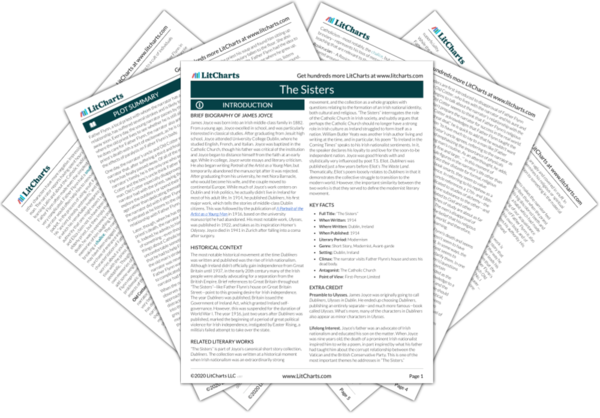Welcome to the LitCharts study guide on James Joyce's The Sisters. Created by the original team behind SparkNotes, LitCharts are the world's best literature guides.
The Sisters: Introduction
The Sisters: Plot Summary
The Sisters: Detailed Summary & Analysis
The Sisters: Themes
The Sisters: Quotes
The Sisters: Characters
The Sisters: Terms
The Sisters: Symbols
The Sisters: Literary Devices
The Sisters: Theme Wheel
Brief Biography of James Joyce

Historical Context of The Sisters
Other Books Related to The Sisters
- Full Title: “The Sisters”
- When Written: 1914
- Where Written: Dublin, Ireland
- When Published: 1914
- Literary Period: Modernism
- Genre: Short Story, Modernist, Avant-garde
- Setting: Dublin, Ireland
- Climax: The narrator visits Father Flynn’s house and sees his dead body.
- Antagonist: The Catholic Church
- Point of View: First-Person Limited
Extra Credit for The Sisters
Preamble to Ulysses. James Joyce was originally going to call Dubliners, Ulysses. He ended up choosing Dubliners, publishing an entirely separate—and much more famous—book called Ulysses. What’s more, many of the characters in Dubliners also appear as minor characters in Ulysses
Lifelong Interest. Joyce’s father was an advocate of Irish nationalism and educated his son on the matter. When Joyce was nine years old, the death of a prominent Irish nationalist inspired him to write a poem, in part inspired by what his father had taught him about the corrupt relationship between the Vatican and the British Conservative Party. This is one of the most important themes he addresses in “The Sisters.”







